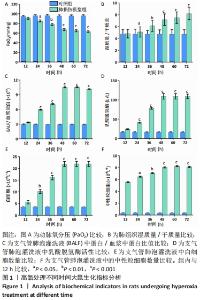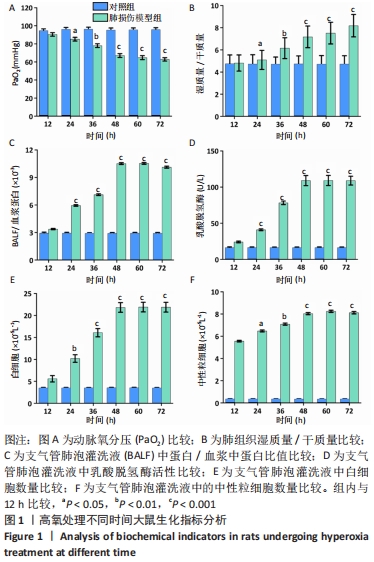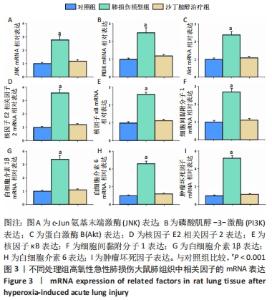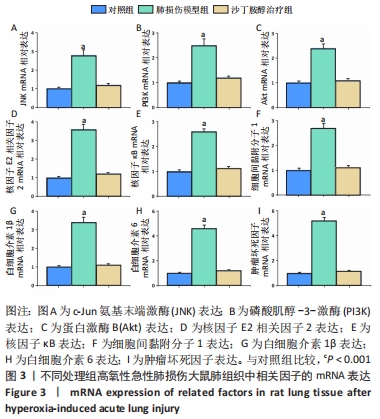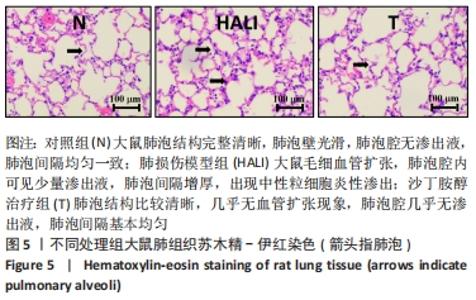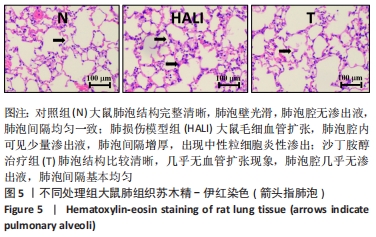Chinese Journal of Tissue Engineering Research ›› 2022, Vol. 26 ›› Issue (23): 3657-3663.doi: 10.12307/2022.664
Previous Articles Next Articles
Salbutamol attenuates hyperoxia-induced acute lung injury in rats
Mei Hong, Qin Song, Li Kang, Chen Miao
- Second Department of Critical Care Medicine, Affiliated Hospital of Zunyi Medical University, Zunyi 563000, Guizhou Province, China
-
Received:2021-04-10Accepted:2021-05-27Online:2022-08-18Published:2022-02-15 -
Contact:Chen Miao, Master, Chief physician, Second Department of Critical Care Medicine, Affiliated Hospital of Zunyi Medical University, Zunyi 563000, Guizhou Province, China -
About author:Mei Hong, Master, Associate chief physician, Second Department of Critical Care Medicine, Affiliated Hospital of Zunyi Medical University, Zunyi 563000, Guizhou Province, China -
Supported by:the Foundation of the Affiliated Hospital of Zunyi Medical University, No. (2015)32 (to MH); the National Natural Science Foundation of China, No. 81960362 (to QS)
CLC Number:
Cite this article
Mei Hong, Qin Song, Li Kang, Chen Miao. Salbutamol attenuates hyperoxia-induced acute lung injury in rats[J]. Chinese Journal of Tissue Engineering Research, 2022, 26(23): 3657-3663.
share this article
Add to citation manager EndNote|Reference Manager|ProCite|BibTeX|RefWorks
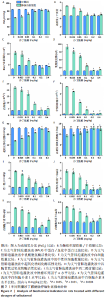
这些结果表明,构建急性高氧性肺损伤模型最佳的高氧处理时间为60 h。 2.3 沙丁胺醇最优使用剂量的筛选 不同给药剂量处理大鼠12 h后收集样品进行生化指标检测。与正常对照大鼠相比,药物剂量较低时除颈动脉血氧合指数(动脉氧分压)、谷胱甘肽过氧化物酶值和超氧化物歧化酶值发生极显著的降低(P < 0.001)外,其他生化指标值(肺通透指数:支气管肺泡灌洗液中蛋白/血浆中蛋白)、右肺副叶湿干质量、乳酸脱氢酶、白细胞数量、中性粒细胞数量、乳酸脱氢酶、丙二醛、白细胞介素8、白细胞介素1和肿瘤坏死因子水平均出现极显著的升高(P < 0.001);沙丁胺醇治疗组随着药物浓度的增加,各生化指标值逐渐向正常大鼠水平接近,见图2。这些结果表明,沙丁胺醇雾化给药处理最佳的使用剂量为0.2 mg/kg。"
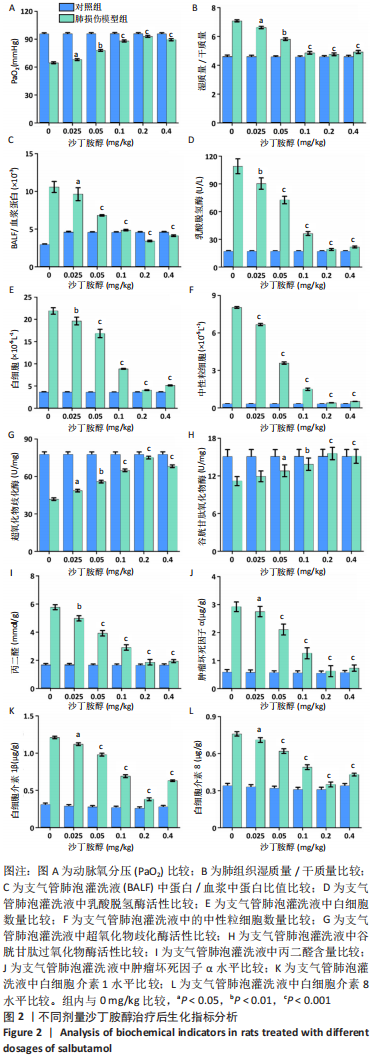
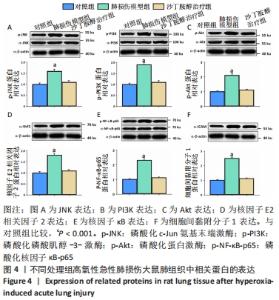
2.5 PI3K/Akt通路中相关蛋白的表达水平 分别收集对照、最佳高氧处理时间和最佳沙丁胺醇给药剂量处理高氧性急性肺损伤大鼠肺组织进行Western-blot检测。与肺损伤模型组相比,对照组和沙丁胺醇治疗组大鼠肺脏组织JNK、核因子E2相关因子2、核因子κB-p65、PI3K、Akt和细胞间黏附分子1的蛋白表达量均极显著的降低(P < 0.001),见图4。值得注意的是沙丁胺醇治疗组大鼠肺脏JNK、PI2K、Akt、核因子κB-p65的磷酸化水平明显降低(P < 0.05)。上述结果表明高氧性急性肺损伤大鼠中PI3K/AKT信号通路相关蛋白的表达水平发生了极显著升高,而沙丁胺醇可以缓解这种现象。"
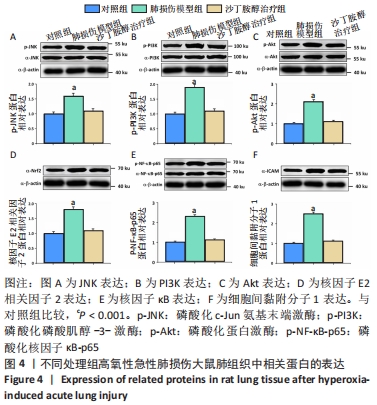
| [1] PAN YQ, HOU A. Hyperoxia-induced lung injury increases CDKN1A levels in a newborn rat model of bronchopulmonary dysplasia. Exp Lung Res. 2018;44(8-9):424-432. [2] CHEN CM, HWANG J, CHOU HC, et al. Tn (N-acetyl-d-galactosamine-O-serine/threonine) immunization protects against hyperoxia-induced lung injury in adult mice through inhibition of the nuclear factor kappa B activity. Int Immunopharmacol. 2018;59:261-268. [3] HONG CY, ZHANG HD, LIU XY, et al. Attenuation of hyperoxic acute lung injury by Lycium barbarum polysaccharide via inhibiting NLRP3 inflammasome. Arch Pharm Res. 2019;42(10):902-908. [4] RATHINASABAPATHY A, HOROWITZ A, HORTON K, et al. The Selective Angiotensin II Type 2 receptor agonist, compound 21, attenuates the progression of lung fibrosis and pulmonary hypertension in an experimental model of bleomycin-induced lung injury. Front Physiol. 2018;9:180. [5] JABBAL S, LIPWORTH BJ. Sensitivity of lung resistance and compliance to beta-blocker induced bronchoconstriction and long acting beta-agonist withdrawal in COPD. Lung. 2018;196(1):15-18. [6] LEWIS SR, PRITCHARD MW, THOMAS CM, et al. Pharmacological agents for adults with acute respiratory distress syndrome. Cochrane Database Syst Rev. 2019;7(7):CD004477. [7] WU X, LI S, WANG X, et al. Therapeutic role of terbutaline in a rat whole-lung lavage model.Exp Lung Res. 2011;37(9):542-548. [8] SALDIAS FJ, LECUONA E, COMELLAS AP, et al. beta-adrenergic stimulation restores rat lung ability to clear edema in ventilator-associated lung injury. Am J Respir Crit Care Med. 2000;162(1):282-287. [9] BOSMANN M, GRAILER JJ, ZHU K, et al. Antiinflammatory effects of beta2 adrenergic receptor agonists in experimental acute lung injury. FASEB J. 2012;26(5):2137-2144. [10] WANG Z, LV Y, ZHANG D, et al. In Vivo Effects of Salbutamol Residues on Blood Lipid, Lung Structure, Gene Expression, and Gut Microorganism Composition. ACS Omega. 2019;4(24):20644-20653. [11] POZZOLI C, BERTINI S, POLI E, et al. Relaxing effects of clenbuterol, ritodrine, salbutamol and fenoterol on the contractions of horse isolated bronchi induced by different stimuli. Res Vet Sci. 2020;128:43-48. [12] SUN Y, QIN L, LIU C, et al. Exploring the influence of drug content on DPI powder properties and potential prediction of pulmonary drug deposition. Int J Pharm. 2020;575:119000. [13] ZHANG R, WU J, LIU S, et al. Spatial Distribution of (R)-salbutamol in Rat Brain Following Nasal and Intravenous Administration Using DESI-MS. Pharmaceutics. 2020;12(1):35. [14] LOURENÇO LO, LOPES ACR, ZAVAN B, et al. Vagotomy influences the lung response to adrenergic agonists and muscarinic antagonists. Respir Physiol Neurobiol. 2020;274:103358. [15] MORI A, HIGASHI K, WAKAO S, et al. Probucol prevents the attenuation of β 2-adrenoceptor-mediated vasodilation of retinal arterioles in diabetic rats. 2017;390(12):1247-1253. [16] 石敏. 高氧性急性肺损伤(HALI)的炎症发生机制及内毒素血症对HALI的影响[D]. 北京:中国人民解放军军医进修学院,2007. [17] PATIL SS, HERNÁNDEZ-CUERVO H, FUKUMOTO J, et al. Alda-1 attenuates hyperoxia-induced mitochondrial dysfunction in lung vascular endothelial cells. Aging (Albany NY). 2019;11(12):3909. [18] WU Q, CHONG L, SHAO Y, et al. Lipoxin A4 reduces hyperoxia-induced lung injury in neonatal rats through PINK1 signaling pathway. Int Immunopharmacol. 2019;73:414-423. [19] ZHENG G, REN H, LI H, et al. Lycium barbarum polysaccharide reduces hyperoxic acute lung injury in mice through Nrf2 pathway. Biomed Pharmacother. 2019;111:733-739. [20] 周学军. 大剂量多种药物中毒致呼吸心跳骤停1例抢救成功体会[J]. 中国中医急症,2010,19(2):335-335. [21] 陈一农, 张吟, 郑兴中, 等. 中毒剂量与治疗剂量克仑特罗在兔体内的药动学研究[J]. 中国现代应用药学,2005,22(4):272-275. [22] CHOI S, JEON S, YIM DS, et al. Contribution of Trough Concentration Data in the Evaluation of Multiple-Dose Pharmacokinetics for Drugs with Delayed Distributional Equilibrium and Long Half-Life. Drug Des Devel Ther. 2020;14:811-821. [23] WANG X, WANG J. Analysis of the advantages and disadvantages in application of oxygen-driven aerosol and aerosol inhalation by air compressor for the pediatric asthma.Pak J Pharm Sci. 2018;31 (6(Special)):2847-2850. [24] TIZIANO FD, LOMASTRO R, ABIUSI E, et al. Longitudinal evaluation of SMN levels as biomarker for spinal muscular atrophy: results of a phase IIb double-blind study of salbutamol. J Med Genet. 2019;56(5):293-300. [25] DEMIREL BD, AYÇIÇEK T, GÜN S, et al. Evaluation of the histopathological effects of salbutamol inhaler treatment in an experimentally induced rat model of pulmonary contusion.Turk J Med Sci. 2018;48(6): 1285-1292. [26] GRAILER JJ, HAGGADONE MD, SARMA JV, et al. Induction of M2 regulatory macrophages through the β2-adrenergic receptor with protection during endotoxemia and acute lung injury. J Innate Immun. 2014;6(5):607-618. [27] WU X, WANG Z, QIAN M, et al. Adrenaline stimulates the proliferation and migration of mesenchymal stem cells towards the LPS-induced lung injury. J Cell Mol Med. 2014;18(8):1612-1622. [28] BLENK N, KUNKEL SL. Endogenous norepinephrine regulates tumor necrosis factor-α production from macrophages in vitro. J Immunol. 1994;152(6):3024-3031. [29] HUANG JL, ZHANG YL, WANG CC, et al. Enhanced phosphorylation of MAPKs by NE promotes TNF-α production by macrophage through α adrenergic receptor.Inflammation. 2012;35(2):527-534. [30] DONNELLY LE, TUDHOPE SJ, FENWICK PS, et al. Effects of formoterol and salmeterol on cytokine release from monocyte-derived macrophages. Eur Respir J. 2010;36(1):178-186. [31] SAMANTA J, SINGH S, ARORA S, et al. Cytokine profile in prediction of acute lung injury in patients with acute pancreatitis. Pancreatology. 2018;18(8):878-884. [32] XU F, LUO M, HE L, et al. Necroptosis contributes to urban particulate matter-induced airway epithelial injury. Cell Physiol Biochem. 2018; 46(2):699-712. [33] DING Q, LIU G, ZENG Y, et al. Glycogen synthase kinase‑3β inhibitor reduces LPS‑induced acute lung injury in mice. Mol Med Rep. 2017; 16(5):6715-6721. [34] QIU Y, XIAO Z, WANG Y, et al. Optimization and anti-inflammatory evaluation of methyl gallate derivatives as a myeloid differentiation protein 2 inhibitor. Bioorg Med Chem. 2019;27(20):115049. [35] IBRAHIM YF, MOUSSA RA, BAYOUMI AMA, et al. Tocilizumab attenuates acute lung and kidney injuries and improves survival in a rat model of sepsis via down-regulation of NF-κB/JNK: a possible role of P-glycoprotein. Inflammopharmacology. 2020;28(1):215-230. [36] ZHANG Y, HUANG T, JIANG L, et al. MCP-induced protein 1 attenuates sepsis-induced acute lung injury by modulating macrophage polarization via the JNK/c-Myc pathway. Int Immunopharmacol. 2019; 75:105741. [37] JIN H, YANG X, ZHAO K, et al. Glycogen synthase kinase-3 beta inhibitors protectagainst the acute lung injuries resulting from acute necrotizing pancreatitis.Acta Cir Bras. 2019;34(6):e201900609. [38] GAUDET A, PORTIER L, PRIN M, et al. Endocan regulates acute lung inflammation through control of leukocyte diapedesis. J Appl Physiol (1985). 2019;127(3):668-678. [39] ZHANG C Y, LIN W, GAO J, et al. pH-Responsive Nanoparticles Targeted to Lungs for Improved Therapy of Acute Lung Inflammation/Injury. ACS Appl Mater Interfaces. 2019;11(18):16380-16390. [40] LI G, ZHOU L, ZHANG C, et al. Insulin-like growth factor 1 regulates acute inflammatory lung injury mediated by influenza virus infection. Front Microbiol. 2019;10:2541. [41] SUI H, LUO M, MIAO Y, et al. Cystic fibrosis transmembrane conductance regulator ameliorates lipopolysaccharide-induced acute lung injury by inhibiting autophagy through PI3K/AKT/mTOR pathway in mice. Respir Physiol Neurobiol. 2020;273:103338. [42] SHI J, YU J, ZHANG Y, et al. PI3K/Akt pathway-mediated HO-1 induction regulates mitochondrial quality control and attenuates endotoxin-induced acute lung injury. Lab Invest. 2019;99(12):1795-1809. |
| [1] | Wang Jianping, Zhang Xiaohui, Yu Jinwei, Wei Shaoliang, Zhang Xinmin, Xu Xingxin, Qu Haijun. Application of knee joint motion analysis in machanism based on three-dimensional image registration and coordinate transformation [J]. Chinese Journal of Tissue Engineering Research, 2022, 26(在线): 1-5. |
| [2] | Tang Wenjing, Wu Siyuan, Yang Chen, Tao Xi. Inflammatory responses in post-stroke depression [J]. Chinese Journal of Tissue Engineering Research, 2022, 26(8): 1278-1285. |
| [3] | Zhu Chan, Han Xuke, Yao Chengjiao, Zhang Qiang, Liu Jing, Shao Ming. Acupuncture for Parkinson’s disease: an insight into the action mechanism in animal experiments [J]. Chinese Journal of Tissue Engineering Research, 2022, 26(8): 1272-1277. |
| [4] | Xuan Juanjuan, Bai Hongtai, Zhang Jixiang, Wang Yaoquan, Chen Guoyong, Wei Sidong. Role of regulatory T cell subsets in liver transplantation and progress in clinical application [J]. Chinese Journal of Tissue Engineering Research, 2022, 26(7): 1143-1148. |
| [5] | Liang Xuezhen, Yang Xi, Li Jiacheng, Luo Di, Xu Bo, Li Gang. Bushen Huoxue capsule regulates osteogenic and adipogenic differentiation of rat bone marrow mesenchymal stem cells via Hedgehog signaling pathway [J]. Chinese Journal of Tissue Engineering Research, 2022, 26(7): 1020-1026. |
| [6] | Wang Jifang, Bao Zhen, Qiao Yahong. miR-206 regulates EVI1 gene expression and cell biological behavior in stem cells of small cell lung cancer [J]. Chinese Journal of Tissue Engineering Research, 2022, 26(7): 1027-1031. |
| [7] | Zhang Yujie, Yang Jiandong, Cai Jun, Zhu Shoulei, Tian Yuan. Mechanism by which allicin inhibits proliferation and promotes apoptosis of rat vascular endothelial cells [J]. Chinese Journal of Tissue Engineering Research, 2022, 26(7): 1080-1084. |
| [8] | He Junjun, Huang Zeling, Hong Zhenqiang. Interventional effect of Yanghe Decoction on synovial inflammation in a rabbit model of early knee osteoarthritis [J]. Chinese Journal of Tissue Engineering Research, 2022, 26(5): 694-699. |
| [9] | Liu Chao, Zeng Zhaomu, Wen Xichao, Wu Wensong, Sun Chengyuan, Zheng Kebin. Role and clinical application prospects of exosomal non-coding RNAs in the occurrence and development of glioma [J]. Chinese Journal of Tissue Engineering Research, 2022, 26(24): 3928-3936. |
| [10] | Jiang Chaorui, Xu Yan, Xiong Ying, Zhang Xujing. Preparation and properties of graphene oxide/silk fibroin/rifampicin drug-loading microspheres [J]. Chinese Journal of Tissue Engineering Research, 2022, 26(22): 3467-3473. |
| [11] | Lyu Yuhu, Cheng Lin, Lin Wentao, Peng Fenglin. Role and regulatory mechanism of glycophagy in glycogen metabolism [J]. Chinese Journal of Tissue Engineering Research, 2022, 26(20): 3243-3249. |
| [12] | Zhang Xiaoyun, Li Huanan, Chen Feng, Chai Yuan, Gan Bin, Li Song, Chen Dingpeng. Potential molecular mechanism of Guizhi Shaoyao Zhimu Decoction in the treatment of gouty arthritis based on network pharmacology and molecular docking [J]. Chinese Journal of Tissue Engineering Research, 2022, 26(2): 245-252. |
| [13] | Bai Jiameng, Liu Guangwei, Xie Lu, Mao Yaoyao, He Huichang, Wang Chunjing. Application of mesenchymal stem cells and exosomes in liver regeneration [J]. Chinese Journal of Tissue Engineering Research, 2022, 26(19): 3071-3077. |
| [14] | Zhao Jirong, Yang Tao, Xu Jiancheng, Zhao Ning, Xue Xu, Ma Tong. Action and mechanism of autologous bone marrow aspiration concentrate in the treatment of knee osteoarthritis [J]. Chinese Journal of Tissue Engineering Research, 2022, 26(18): 2938-2944. |
| [15] | You Kun, Liu Yuanxin. Protective effect of exercise preconditioning on lung injury induced by hypobaric hypoxia in rats based on the nuclear factor E2-related factor 2/antioxidant response element signal pathway [J]. Chinese Journal of Tissue Engineering Research, 2022, 26(17): 2702-2707. |
| Viewed | ||||||
|
Full text |
|
|||||
|
Abstract |
|
|||||
